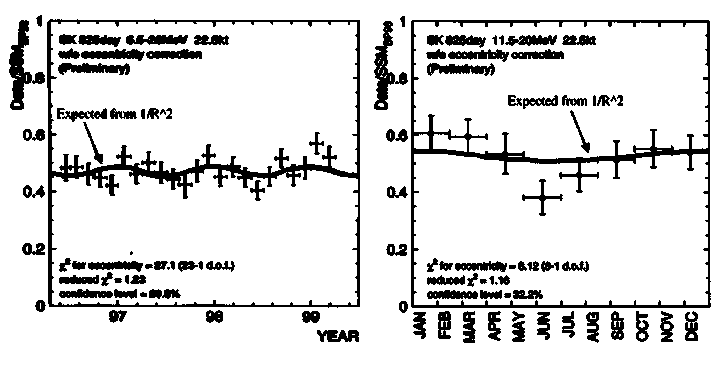Solar neutrinos: Experiments
 Link to Solar neutrinos: Theory page.
Link to Solar neutrinos: Theory page.
Experimental results
The experimental research on solar neutrinos started on late sixties with the experiment at Homestake. It employs a radiochemical method, where a neutrino may induce a nuclear reaction
and the resulting argon nuclei are counted by their radioactive decay.
The three gallium experiments, SAGE, Gallex and GNO use a similar
technique, using the reaction

Kamiokande and SuperKamiokande are water Cerenkov detectors
looking mainly for the elastic scattering process.
The charged lepton is detected by its Cerenkov radiation.
These detectors can measure the energy and direction
of the neutrino at real time. Because
of the angular resolution they can distinguish neutrinos
coming from the Sun from the background.
SNO is also a Cerenkov detector, filled with heavy water. It can distinguish
charged current and neutral current reactions.
Below CC refers to charged current reaction, NC to neutral current
reaction and ES is elastic scattering,
as in SK.
| Experiment | measured flux | ratio exp/BP98 | threshold energy | Years of running |
|---|---|---|---|---|
| Homestake | 2.56 ± 0.16 ± 0.16 | 0.33 ± 0.03 ± 0.05 | 0.814 MeV | 1970-1995 |
| Kamiokande | 2.80 ± 0.19 ± 0.33 | 0.54 ± 0.08 +0.10-0.07 | 7.5 MeV | 1986-1995 |
| SAGE | 75 ± 7 ± 3 | 0.58 ± 0.06 ± 0.03 | 0.233 MeV | 1990-2006 |
| Gallex | 78 ± 6 ± 5 | 0.60 ± 0.06 ± 0.04 | 0.233 MeV | 1991-1996 |
|
Super- Kamiokande |
2.35 ± 0.02 ± 0.08 | 0.465 ± 0.005 +0.016-0.015 (BP00) | 5.5 (6.5) MeV | 1996- |
| GNO | 66 ± 10 ± 3 | 0.51 ± 0.08 ± 0.03 | 0.233 MeV | 1998- |
| SNO |
1.68 ±
0.06 ± +0.08 -0.09 (CC)
2.35 ± 0.22 ± 0.15 (ES) 4.94 ± 0.21 +0.38-0.34 (NC) |
6.75 MeV | 1999- |
- The values for Chlorine and Gallium experiments are given in SNU.
- The values for Cerenkov experiments are given in units of 1010 counts/m2 s.
- The errors for the relative values correspond to experimental and theoretical errors, respectively, with the statistical and systematic errors added quadratically. Some of the relative values are based on my own calculation from the published results.
- BP98 Refers to Bahcall and Pinsonneault model of 1998.
SuperKamiokande has provided additional data:
- Day night asymmetry (2000)
D-N
------- = - 0.034 ± 0.022 ± 0.013
D+N
See the plot (1999):

- Seasonal variation: No visible distortion beyond the eccentricity
of the orbit.
See the plot:

Future projects
| Experiment | Place | method | sensitivity | threshold energy | scheduled to start |
|---|---|---|---|---|---|
| Borexino | Gran Sasso | Liquid Scintillator | charged and neutral currents |
0.25 MeV or less |
200? |
| ICARUS | Gran Sasso | liquid argon image chamber |
all neutrinos | 5.9 MeV | 2005 (?) |
| HELLAZ | Gran Sasso | Helium gas in time projection chamber |
mostly electron neutrinos |
0.2 MeV | > 200? |
| Iodine | Homestake | radiochemical | electron neutrinos | ||
| HERON | phonon excitation in superfluid helium |
mostly electron neutrinos | (0.5 keV?) | >> 2005 | |
| CLEAN | Liquid helium | electron neutrinos | low | still dream | |
| LENA | scintillator | >> 2005 | |||
| UNO | Megaton Cherenkov | still dream | |||
| MEMPHYS | Megaton Cherenkov | still dream | |||
| HYPER-K | Megaton Cherenkov | still dream |
Also other proposals exist.
Solutions
| Solution | Status | Requirement | Time dependence | Other features | Original references |
|---|---|---|---|---|---|
| Resonant conversion to muon or tau neutrinos | a good fit, well motivated | mixing of neutrinos, mass O(10-3 eV), see plot. | day night effect for large mixing | large angle solution best fit | Mikheyev and Smirnov (86), Wolfenstein (78). |
| Resonant conversion to sterile neutrinos | disallowed by SNO data | mixing of neutrinos, mass O(10-3 eV), see plot. | day night effect for large mixing | ||
| vacuum oscillation | not a good fit inconsistent with SNO |
mixing of neutrinos, mass O(10-5 eV), see plot. | annual variations | Pontecorvo (67) | |
| helicity flip | bad fit | magnetic moment O(10-11 µB). | anticorrelation with sunspots | solar magnetic field unknown | Voloshin, Vysotsky and Okun (86) |
| resonant spin-flavor conversion | still alive
(hard to kill) unmotivated |
magnetic moment O(10-11 µB), mass O(10-3 eV). | anticorrelation with sunspots | taking the solar magnetic field as free parameter fits all the results |
Akhmedov (88) Lim and Marciano (88) |
| neutrino decay | inconsistent | lifetime < 8 min | static | constrained by SN1987A | Bahcall, Cabibbo and Yahil (72) Pakvasa and Tennakone (72) |
| solar astrophysics | desperate | new physics inside the sun | model dependent | Conflicts helioseismology |
The solar neutrino problem can be considered as an almost solved case.
for the oscillation parameters.
Go to Solar neutrinos: Theory page.
Back to mainpage